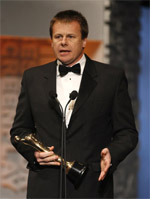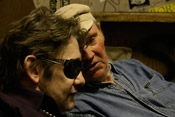Alan Gilsenan’s latest venture, ‘The Yellow Bittern’, is a feature length documentary which paints an intimate portrait of the folk singer Liam Clancy, the only remaining member of The Clancy Brothers and Tommy Makem and has been five years in the making.
From humble beginnings in Tipperary and Armagh the film takes the audience from the dizzying heights of the foursome’s fame as the endearingly aran-jumpered Irish folk singers, who out-sold the Beatles and counted Bob Dylan and Pete Seeger as fans, through various highs and lows and alcohol-fuelled blips to today whereby the film’s subject, Liam Clancy, is one of the few remaining members of the Irish folk movement that gripped the United States for more than two decades.
‘The Yellow Bittern’, the title of which is inspired by the Thomas MacDonagh poem of the same name, is powerfully orchestrated and bears the mark of its award winning director Alan Gilsenan (The Hospice, The Asylum). The informal yet austere warehouse setting of the film’s main interview segments sets a relaxed albeit intimate tone as the wall in front of Liam persistently comes alive with old home videos, concert footage and other archive material. Gilsenan may be the film’s director but truly Liam Clancy is the storyteller throughout.
 Alan Gilsenan at the 2008 IFTAs
Alan Gilsenan at the 2008 IFTAs |
The two hour documentary makes use of archive footage, most of it from Liam Clancy’s private collection, including his wedding video which neither he nor his wife, Kim, had seen prior to making ‘The Yellow Bittern’.
The film hits selected Irish cinemas tomorrow, September 11, and IFTN caught up with both Alan Gilsenan and Liam Clancy to discuss the project.
IFTN: Throughout ‘The Yellow Bittern’ we are presented with a recurring scene where we see Liam on an empty sound stage at Ardmore Studios looking at the projected archives, with you, Alan, facing him - is this an approach to interviewing that you might use again?
Alan Gilsenan: Yes, it seemed right. It was our starting point.
Liam Clancy: I remember talking, in the early days, about the John Houston film ‘Moulin Rouge’ and when I first started writing a memoir I had in mind this image of the death bed scene in that film and all the people from the Moulin Rouge - they come trooping in by the bedside saying “So sorry you are dying darling,” and then a dancer does a bit of a dance and all these ghosts flit in and out. Somehow, I don’t know whether we talked about it or not, but Alan put me in the big Ardmore Studios and he made all the ghosts of the people I was talking about appear. He brought them all to life.
This ghost theme, was it something that came about naturally?
Alan: When you are in the audience and you see Liam on stage, possibly in a huge auditorium or a small auditorium, and it’s that man on stage, on his own, in a pool of light, and at times surrounded by thousands - I think you bring to the interpretation of a song your past and your history. I suppose that was the initial idea, that we would start with this quite stark, very lengthy interview in Ardmore which would then form the basis for the film. There is the sense that sometimes, in the darkened stage, you can imagine the ghosts coming and going.
And you are in-shot for many of the interviews Alan, as are your crew. Was this consciously done?
Alan: Yes it was consciously done but not intellectually done if you know what I mean. I think a lot of the time you just have to follow your heart and gut and it just seemed right. Liam is such an amazing storyteller and song writer and then in the darkness are the ghosts, friends, performers, experiences so it just seemed like a good place to start.
You both met up in May 2005 and started talking about this project. How different is the finished product from what you discussed back then?
Alan: Well, I obviously pontificated a lot and since then I have obviously disappointed Liam a lot but that’s what happens you do your best. You do your best.
Liam: You did your best son! Well, I think it came out very much like I wanted to see it anyway. I am sometimes quite amazed at Alan’s knowledge of life and his insights into it. His instincts are so spot on and it’s very rare that someone is lucky enough to get a director who is so interested, in-tune and on the same wavelength as yourself and capturing what you want to see.
Tommy Mackem died during production of ‘The Yellow Bittern’. Did that change the tone or direction of the documentary?
Alan: I don’t think so in that we were always telling this story, it was Liam’s story and obviously his brothers and Tommy are a part of that. I suppose we have often talked about the transience of everything - of success and these boys having huge fame and glamour and success. The passing of that and the transience of life. I don’t know what Liam felt but when Tommy died you realised how true that was.
Liam: How really transient it is and I realise it even more now.
Alan: Unfortunately I never met Liam’s other brothers, but having met Tommy and for him to go there is the sense when you look at the archive and see Tommy singing ‘Four Green Fields’ with such passion and power it is hard to believe that it passes.
Liam: You wonder where it goes to. There were many times towards the end, especially through the reunion concert, where the four of us came together and performed together after fifteen years and Paddy and Tom are that much older. Standing back when Paddy or Tom are singing a song and the different coloured lights are shining on their faces, one becomes so aware that this is smoke sculpture. We are moulding it now but then the smoke is gone it can never be repeated. You don’t repeat the song the next night and if you do you have to make it new so when the smoke is coming out you have to mould it. One of the great things is we have so much preserved now on film.
 Liam Clancy and Shane McGowan
Liam Clancy and Shane McGowan |
This is, as we mentioned before, a feature-length documentary. Is there an Irish appetite for that kind of genre?
Alan: I think there has been an upsurge in cinema documentary worldwide, partly because television documentary has become so formulaic. I think people are interested in different types of films and cinema documentary but also the other side of that is Liam. I’ve seen Liam play all over the place; New York, Milwaukee, Carrick-on-Suir, Longford - wherever you go there is a passionate audience there. They go to see him so, I hope, they go and see the film.
I think that is because Liam has been interpreting their world for them. One of the things that I have always admired about him, and I don’t think I have said this to you Liam, is that dedication of giving a good night out. Whether it’s in terms of making people laugh or cry there is something great about going to a Liam Clancy concert. When you see that audience, whether it’s in an arts centre in Sligo or whether it’s in New York, you see that audience moved and touched and have something articulated for them through this performance - that’s really what it is all about.
‘The Yellow Bittern’, the title itself it obviously comes from the Thomas McDonough poem but during the documentary we hear you recite quite a few snippets of other poems, why was ‘The Yellow Bittern’ chosen as the titular piece?
Alan: I don’t know. Sometimes with films you hit on the title very early and it seems right and in this case we didn’t. In one of the very last interviews we did with Liam at home in the house he mentioned the end of the film about being like ‘The Yellow Bittern’, and when I read the poem and heard Liam recite the poem it just seemed right. I think it is partly to do with the poem itself.
What I like is that Liam is an extraordinary storyteller, somebody who exposes himself through performance. But there is also the private Liam that is precious and special like the yellow bittern. I think that is the enigma of the performer who exposes everything and yet also has to keep a litte bit back. It wasn’t a logical choice but just seemed right.
- ‘The Yellow Bittern’ from Element Pictures was produced by John Murray and Anna Rogers and edited by Oliver Fallen. Director of photography was Richard Kendrick, Keith Horgan was in charge of sound and Production Manager on set was Siobhán Ward.
- ‘The Yellow Bittern’ will be screened in the Light House Cinema, IFI, Movies @ Dundrum and Movies @ Swords in Dublin, The Gate Cinema in Cork, The Eye Cinema in Galway and SGC in Dungarvan as of tomorrow September 11th.
